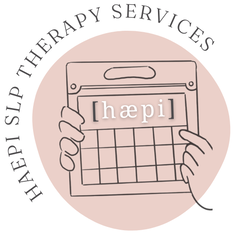|
We have had such a great response to our baby/toddler check-in sessions, and are thrilled to share that we will have 3 SLPs (Halle, Megan, Linsey) able to provide these services over the summer months of July & August.
Here are the answers to a few FAQ: Where do sessions take place? We come to you! We can work with you at your home, daycare, or community setting (park, playground, etc.) within Thunder Bay. Most parents LOVE that we can see you at home, since that's one less transition for you and your little one (plus not having to find childcare for siblings is a bonus!), and we can provide strategies to try using the things you already have in your home! What is the frequency of sessions? This is flexible, and we will work with you and your child to determine the best frequency. It may be one time, biweekly, monthly, or every couple of months. Services can be paused or discontinued at any time. Is this service eligible for reimbursement through private insurance/benefits? Absolutely! Many insurance plans cover speech language pathology services. We recommend checking with your benefits provider first to clarify what coverage is available by your plan . Have any other questions? Drop them below! by Halle Demchuk, SLPPaediatric SLP | GLP-Trained Clinician | Owner of HAEPI SLP
Our gestalt language processors' first step in their language development is acquiring verbatim scripts or phrases that are meaningful to them, and using them spontaneously later in other contexts (this is referred to as "delayed echolalia" or using "gestalts").
The great thing is that our GLPs will acquire phrases when they are modelled naturally, but there are a few considerations we should keep in mind, such as:
The shift from modelling "survival language" (sentence strips, single words, labelling) can feel like a big one, but your GLP will develop more flexible language if we meet them where they are at as gestalt language processors. by Halle Demchuk, SLPPaediatric SLP | GLP-Trained Clinician | Owner of HAEPI SLP
Today we "commuted" 850 km by plane to our most Northern community, which we are traveling to both this week and next.
The views were amazing as always, though it did get cold near the end, and there is still a little bit of snow left here (even though it's the end of May)! My favourite part was finding some shells from the Arctic Ocean! by Halle Demchuk, SLPPaediatric SLP | GLP-Trained Clinician | Owner of HAEPI SLP
We were so honoured to each receive a custom-made Ribbon Skirt last week when visiting a fly-in Indigenous community.
I think the highlight of the trip was when the kokums (grandmas) made us spin around while the Kindergarteners told us how beautiful the skirts were. We love this description from www.theribbonskirtproject.ca: "For Indigenous peoples, the Ribbon Skirt represents our own personal reclamation. It represents reclaiming identity, and wearing that identity proudly. It has become armour. It is a cultural protection against assimilation and degradation. It is a reminder of our roles in our community as women and as members. It reminds us of our sacredness as women and the power in that. It tells our story of adaptation and survival." And how fitting is the pink? by Halle Demchuk, SLPPaediatric SLP | GLP-Trained Clinician | Owner of HAEPI SLP
After 3 years of traveling to northern remote communities that are only accessible by plane, I've learned a few tips & tricks so that the trips go as smoothly as possible...
1. Batch meal-prepping. I am not kidding when I say I'll make 6 chicken pot pies at once, or two full crockpots of chilli. Soups, bagels, banana bread, casseroles, etc. are great for bringing up North and reheating, and have the added benefit of acting like an ice pack (since space can be scarce!). 2. Bring up as much water as we can. There are still 26 First Nations communities (and no, that's not a typo) without access to clean drinking water. We are visiting one this week. Even if a community is not under a water advisory, things can happen that result in not having drinking water. 3. Pack an extra set of clothes (and food) in a carry-on. This is good practice wherever you travel, but since we have to take 2 flights to get to each community, that is double the chance of lost or stuck luggage. Learned this one the hard way! Have questions about being an SLP/service provider with Northern travel? Drop them below! by Halle Demchuk, SLPPaediatric SLP | GLP-Trained Clinician | Owner of HAEPI SLP |
The HAEPI BlogCheck here for HAEPI updates, helpful SLP information, free resources, articles, and more!
Archives
June 2024
Categories
All
|
Empowering Happy Communicators |
get in touch |
Quick Links |
© HAEPI SLP THERAPY SERVICES.
HAEPI SLP Therapy Services is proudly neurodiverse, Indigenous-owned, and woman-operated.



